
Purple peyote seedlings - a sign of extreme conditions
A purple colored epidermis is a common stress indicator for a number of cacti - stress caused either by cold or draught - and consequently can be seen as a sign of extreme growing conditions.
The peyote seedlings in the above photo haven’t seen a drop of water since late August/early September, i.e. they have been without water for almost half a year. And the last time I checked, the temperature in the coldhouse where the seedlings grow had been as low as -10C (14F). Extreme conditions for peyote seedlings indeed! And the explanation for their purple hue.
The plants are grown from seed originating from El Oso, Coahuila, Mexico. Given the locality and the seedlings’ ability to endure extreme cold and dry conditions I expect them to be Lophophora williamsii var. echinata.
Speaking of purple Lophophora williamsii var. echinata the below photo was posted a while ago by Keeper Trout. The picture shows a patch of mature peyote turned purple by the cold. According to Trout, the area in Texas where the plants grow had experienced a "hundred year freeze" including three days where the highest temperature measured at a nearby locality was 10F (less than -12C).

Purple peyote in habitat in Texas
The frost in western Texas killed off a lot of things considered freeze-hardy - including the dead peyote pictured below. This plant was from a different population than the purple patch pictured above and might have seen slightly colder temperatures, but still it’s a good indication that the freezing temperatures these plants experienced are at the limit of what Lophophora williamsii var. echinata will stand.

Dead peyote in habitat in Texas
As mentioned at the beginning of this post a purple tinted epidermis is a common sign of stress in many cacti. Another example from my coldhouse is the purplish-hued Ariocarpus retusus pictured below.

Purple tinted Ariocarpus retusus (SB 310; Cuesta la Muralla, Coahuila)
The mature peyote photos are courtesy of Keeper Trout and the Cactus Conservation Institute and originate from this post on The Corroboree.
Thursday, February 21, 2013
Peyote purple from extreme cold
Tuesday, February 12, 2013
Peyote, Ariocarpus and Normanbokea in the depth of winter

Winter dormant peyote cactus
Following a relatively mild period the last couple of years have seen freezing cold winters here in Denmark - winters that have been tough to my coldhouse grown plants, and especially the deep frost of 2009/2010 killed off a significant number of my coldhouse collection. But it also separated the wheat from the chaff leaving a pretty cold-hardy assemblage of plants, the dormant Lophophora williamsii var. echinata (JJH 8608293; Pecos River area) pictured above being a majestic example.

Ariocarpus kotschoubeyanus var. macdowellii (SB 100; El Pilar, Coahuila)
Most of the cacti growing in the coldhouse are selected for their (sometimes assumed) ability to survive freezing conditions. For example I prefer the Trans-Pecos variety of peyote as it is more frost hardy than the tender regular variety - and the different Ariocarpi all originate from the northernmost part of the species’ respective ranges.
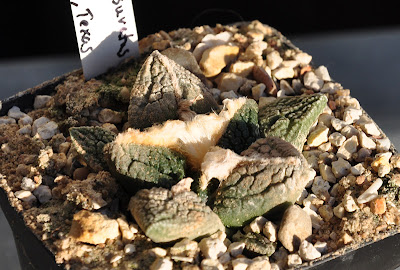
Ariocarpus fissuratus (SB 403; Crockett Co, Texas)
Even though the cacti already have survived several cold winters I can’t deny that I still worry what plants will die off during winter (as some inevitably will).
The pictures appearing in this post were taken between Christmas and New Year - at that time the plants had already been exposed to temperatures in the vicinity of -10 C (approximately 14 F). Since then they have seen both mild and humid weather and long periods of frost - I expect that these fluctuations in temperature are harder to cope with for the plants than uniform periods of cold, but it’s just a hunch. Anyway I’m eagerly looking forward to spring :-)

Ariocarpus retusus (SB 310; Cuesta la Muralla, Coahuila)
But it is not just the cold that poses a threat to my plants. Previously critters have eaten large bites out of some of my peyote plants and now several of my Normanbokea valdeziana plants have met the same destiny... I still haven’t figured out what culprit is eating my cacti (or at least tasting and spitting out again)!

Normanbokea valdeziana (SB 1468; Ramos Arizpe, Coahuila, Mexico) eaten into by some unknown critter
Tuesday, January 08, 2013
Time-lapse video of a flowering Ariocarpus kotschoubeyanus var. macdowellii cactus
Flowering Ariocarpus kotschoubeyanus var. macdowellii (SB 100; El Pilar, Coahuila) - please note that the time-lapse video is generated with a fairly high frame rate meaning that you can slow down the video to 0.5x its speed (or even 0.25x) with good results - the playback speed is controlled via the settings for the YouTube video.
As mentioned in the previous post I broke the shutter of my old faithful Nikon D70 SLR camera while capturing photos for a time-lapse video of a flowering peyote. A time-lapse video of just a few seconds duration requires hundreds of photos and thus imposes a considerable wear on SLR cameras with mechanical shutters. Consequently I have avoided using my new SLR for time-lapse shooting and instead experimented with alternative solutions. One of these being iTimeLapse Pro for the iPhone - an app that allows you to control basic settings like the capture interval, when to stop and start capturing images, and the capture resolution.
The app was used for shooting the images for this video and as such functions just fine, but I still need to work on enhancing the steadiness of the phone (it slid slightly on its stand during the capture sequence), and on tuning the focus (which is slightly behind the center of the flower, making the flower itself look blurry). Also the images are taken in natural light that changes continuously giving the video a flickering appearance - on the other hand the change in light is also responsible for the flower closing again, adding to the video.
I also shot photo sets for a flowering peyote ( Lophophora williamsii var. echinata) and a Gymnocalycium calochlorum and will generate and upload time-lapse videos for these as time permits.
For the technically inclined it must be mentioned that the video was generated using FFmpeg, a free set of tools to record, convert, stream and play multimedia content. FFmpeg can be downloaded here. The photos used in the video were shot one every 15 seconds and is played back at a rate of 25 images per second. The time-lapse video comprises 1001 still images.
If the video doesn't embed properly you can view it in a separate window by clicking the picture below.

Sunday, April 11, 2010
The killing frost – casualties and survivors
First a bit of background information so that you guys won’t believe that I am completely stupid growing Lophophora and the likes in an unheated greenhouse in Denmark: 1) Most of these plants are “surplus”, i.e. I don’t have room for them anywhere else – lately several plants have been bought specifically for the cold house, though. 2) The greenhouse is located at my summerhouse, left mostly desolate throughout winter, making it difficult to keep it reliably heated. 3) Many cactus species tolerate more frost than is generally assumed; I’m curious which. 4) The winters in Denmark have been rather mild lately, inviting experiments like this.
With this in place I’m ready to recount how the harsh winter, that has just released its cold grip of Denmark, helped me separate the wheat from the chaff (a blatant euphemism for “killing off alarmingly large parts of my collection”). Just to give an understanding of the severity of the winter, the plants saw almost constant frost for more than 10 weeks, with temperatures measured as low as -15 C (5 F) in the area where the plants grow.
Lophophora williamsii var. echinata coming out of winter
Let’s start with one of the success stories. My Trans-Pecos peyote plants are doing quite well, approximately one in eight died and the surviving plants are not too marked by the frost. The plants I'm growing are descending from material originally collected in the Pecos River area, Val Verde County, Texas (JJH 8608293). The Trans-Pecos peyote is the northernmost form of Lophophora williamsii and is also known as Lophophora williamsii var. echinata.
Trans-Pecos peyote surviving the frost
My regular (Mexican and south Texan) Lophophora williamsii plants fared much worse, less than one in ten of the larger plants survived the winter. 
One of the few surviving Lophophora williamsii var. williamsii
This corresponds well with Del Weniger’s observations:
[Lophophora williamsii var. echinata] can also survive the much more severe cold of the Big Bend. I have several times had the smaller form from south Texas [L. williamsii var. williamsii] freeze in San Antonio, while this form [L. williamsii var. echinata] growing in the same bed showed no ill effects.
In the future I'll focus more on the extreme northern forms of peyote, i.e. plants grown from material originating from Shafter, Val Verde, Big Bend and other Trans-Pecos, Texas locations. The Cactus Conservation Institute has an informative page on the differences in traits between Lophophora williamsii var. echinata and var. williamsii.

Frost killed Lophophora williamsii, Starr County, Texas
As mentioned the majority of my large “regular” Lophophora williamsii were killed by the frost. But many medium sized seedling plants actually survived while the larger plants (of the same variety) and yearling seedlings succumbed. As this pattern seems to be rather consistent for plants of the same variety, I guess I can’t write all “regular” Lophophora williamsii casualties off to genetics. My theory is that this “size-conditioned” difference in survival must be related to how well the plants were prepared for the winter, which again may be closely related to the surface-area-to-volume ratio of the plant.
The surface-area-to-volume ratio (SA:V) decreases with size, i.e. a large plant will have less surface per unit of volume than a smaller plant. If we use a half sphere as a model for a globular cactus we get a SA:V of 3/r, where r is the radius. Consequently a large plant will need relatively longer time (per unit of volume) to go flaccid and prepare properly for the winter (as all excess water needs to be evaporated through the surface (the epidermis)). Similarly seedlings are more prone to die of drought as an increased SA:V means increased exposure to the environment in general.
To play it safe the coming growing seasons I'll stop watering my large plants well before I let seedlings go drought dormant in preparation for the winter, and in general start winter preparations earlier than I have used to in the past.
I might consider crossing the surviving mature (non Trans-Pecos) plants and name the cultivar Lophophora williamsii 'Borealis' ;-)

Frost killed Leuchtenbergia principis – outside the rain is weeping
My largest Leuchtenbergia principis is dead (pictured above next to a surviving saguaro) while 3 out of 4 of my smaller Leuchtenbergia principis plants (GL 770; Sierra de la Paila) are looking happy.
Ariocarpus has turned out to be an unconditional coldhouse success. I expected my Ariocarpus fissuratus plants to make it safely through the winter as they originate from locations like Fort Stockton, Texas (JM 122) and Crockett County, Texas (SB 403), but I had doubts about my Ariocarpus kotschoubeyanus var. macdowellii plants (SB 100; El Pilar, Coahuila), and had accepted that I would probably loose my Ariocarpus retusus (SB 310; Cuesta la Muralla, Coahuila). Amazingly they all survived the winter in great style almost looking lush and vigorous, like a winter swimmer surfacing with renewed energy after a cold plunge.

Surviving Ariocarpus, Epithelantha, and Leuchtenbergia plants
Epithelantha is another seriously cold tolerant genus. My Epithelantha micromeris var. greggii plants (Cuesta la Muralla, Coahuila, Mexico) all made it; one is seriously damaged, though – it looks like the root is dead while the crown looks fine, so I hope to be able to re-root it. The Epithelantha bokei plants (SB 416; Brewster Co, Texas) also look fine, but due to the extremely dense spination it is hard to say for sure if they are completely undamaged. Strangely the cold has taken the hardest toll on my regular Epithelantha micromeris (SB1327; near Belen, New Mexico) – this variety of E. micromeris is from the northernmost known locality of the species so I had expected the plants to cope better with the frost.

Surviving Obregonia denegrii plants
Last summer I moved a handful of Obregonia denegrii seedlings (VVZ 163; San Vicente, Tamaulipas) to the coldhouse. I really didn’t expect these plants to be cold hardy, but didn’t have room for them anywhere else. Surprisingly approximately two thirds of the plants survived as illustrated in the above picture (the surrounding pots are not empty, each contain a rather large L. williamsii killed by the cold).
Other success stories are Normanbokea valdeziana, Homalocephala texensis, and Mammillaria meiacantha which all made it through the winter without casualties – the Normanbokea plants are even budding. Acharagma roseana is another species that’s shaking off the winter blues and getting ready to bloom – in general Acharagma seems to handle the cold pretty well, even most of my yearling Acharagma aguirreana seedlings survived. Most Escobaria and Echinocereus obviously had minimal problems with the frost.

Frost killed Lophophora williamsii turning to mush
As mentioned above the majority of my larger, regular Lophophora williamsii plants were killed by the frost, but the more tender Lophophora species like Lophophora diffusa and L. fricii are completely eradicated – I’ll probably not experiment further with these species in the coldhouse, the exception maybe being montane varieties of Lophophora fricii.

Dead Lophophora diffusa
Other species that are completely wiped out include Matucana madisoniorum, an unknown Echinopsis hybrid, Ferocactus glucescens (PP 1354), Lithops lesliei (not exactly a cactus, I know ;-), and Harrisia jusbertii. Surprisingly all my Mammillaria grahamii also died – I had expected this species to be more cold hardy.
Most of my saguaro cactus (Carnegiea gigantea) also succumbed to the frost – 4 plants look like they might survive, most of them badly damaged, but it is too early to say.
I need to start building a new collection of grafting stock – all Trichocereus plants that I grew in the coldhouse are dead, including Trichocereus pachanoi, T. peruvianus, Trichocereus 'Tom Juul’s Giant', and a Penis Cactus… they are all gone. Even plants that were well prepared for the winter died, so Trichocereus is definitely not as tolerant to frost as I had expected.
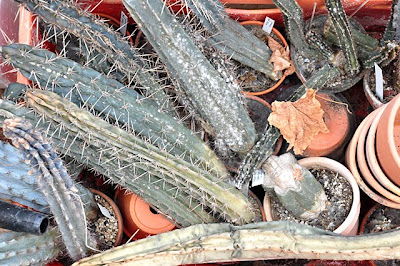
Decomposing Trichocereus plants
To put the death toll into perspective this is the coldest winter in 14 years in Denmark (followed by March, a month with the most extreme temperature fluctuations in 14 years, which were not very becoming to my struggling plants either). The frost set in just before Christmas and only lifted again in the beginning of March. The lowest temperatures measured in the area were as low as -15 C (5 F).

Outdoor temperature in late January
Once in a while short bursts of thaw set in quickly followed by frost (as indicated by the above graph), making the conditions even harder for the plants.

Outdoor temperature in mid February
The temperature measurements come from a semi-professional weather station located approximately 1.5 km (~ one mile) from where I grow my plants, so these temperatures are representative for those that my plants where exposed to.
To end on a positive note I expect the frost to have killed off many pests also (including red spider mites). Also, I got an affirmative confirmation that it is actually possible for peyote to survive rather extreme conditions in an unheated greenhouse in Denmark... and I got plenty of room for new plants ;-)
Tuesday, December 15, 2009
Flowering Ariocarpus kotschoubeyanus var. macdowellii
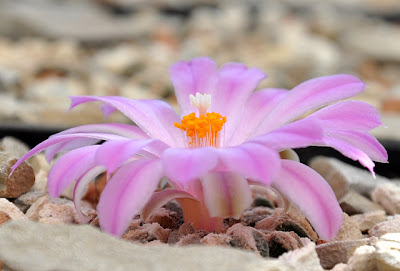
Flowering Ariocarpus kotschoubeyanus var. macdowellii
As mentioned in an earlier post I'm fairly inexperienced when it comes to growing Ariocarpus and still in the process of building a collection of these fascinating plants. A few months ago I bought a handful of plants from Mesa Garden including three Ariocarpus kotschoubeyanus var. macdowellii plants (SB 100; El Pilar, Coahuila).
I didn't really expect the plants to bloom this season but mid-September one of them greeted me with a beautiful, pale purple flower, so large that it completely covered the plant.
Ariocarpus kotschoubeyanus var. macdowellii flower, top view
I'm growing the plants in an unheated greenhouse in Denmark and specifically selected this variety of Ariocarpus kotschoubeyanus as it comes from the northern extreme of the species' range. The Living Rocks website has the following to say on A. kotschoubeyanus var. macdowellii:
The northern populations are characterized by a form, which has become known as A. kotschoubeyanus var. macdowellii, this is found to the west and east of Parras with a range of over 100km from Viesca to Estatcion Marte in Coahuila. A. kotschoubeyanus var. macdowellii is a smaller plant than the type, with small beak-like tubercles and pale mauve flowers, often with a high white content in the outer petals.
If the macdowellii plants survive the winter in the cold house I'm probably also going to test the larger, magenta flowered, southern form of the species, Ariocarpus kotschoubeyanus var. elephantidens.

Ariocarpus kotschoubeyanus var. macdowellii flower bud
I'm growing the plants in a greenhouse at my summerhouse and can't check in on them on a regular basis, so it felt like a stroke of luck when I was met by a budding A. kotschoubeyanus var. macdowellii one late Friday evening in the middle of September. The next day the plant was in full bloom as illustrated by the pictures above. In early October one of the other macdowellii plants also developed a bud, but unfortunately I didn't see it flower.
Regarding cold hardiness, the A. kotschoubeyanus var. macdowellii plants are going to be tested sooner than expected. Denmark has a cold spell coming and the weather report shows temperatures below -10 C (14 F) within the next few days.
Wednesday, October 14, 2009
A few Ariocarpus plants and a handful of Echinocactus seeds from Mesa Garden
I'm not a seasoned Ariocarpus grower but still in a slow but steady process of building a collection of these magnificent plants. I'm learning to handle the deep levels of patience required to grow Ariocarpus from seed, but sometimes I give in to my eagerness and have to buy a few plants ;-)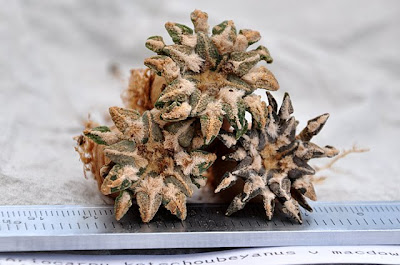
Ariocarpus kotschoubeyanus v. macdowellii
I like Mesa Garden's hard grown plants that almost invariably come with locality information. As I live in Denmark and Mesa Garden is located in New Mexico it is quite cumbersome and expensive to import plants (I once contacted the Danish plant directorate to get directions on importing cacti from countries outside of the European Union and was told it would involve import permits, CITES and phytosanitary documents plus an inspection of the plants upon arrival). To work around these obstacles I order plants whenever in the US and have them shipped to my hotel; from there they travel to Denmark packed in my suit case.
Ariocarpus kotschoubeyanus v. macdowellii, side view
I have only praise for the service offered by Mesa Garden, they are always responsive and extremely helpful in arranging timely deliveries - even within very short windows of time. Remember to specify substitutes, though. 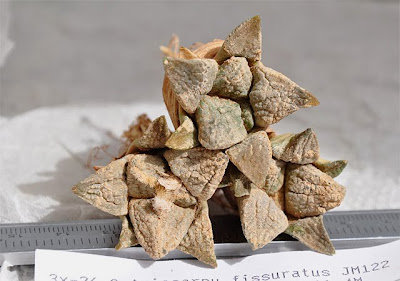
Ariocarpus fissuratus
I spent part of my summer vacation in New York City and again took the opportunity to order plants and seeds from Mesa Garden. Apart from the Ariocarpus kotschoubeyanus var. macdowellii (SB 100; El Pilar, Coahuila) and A. fissuratus (JM 122; Fort Stockton, Texas) featured in this post, I also ordered some Ariocarpus intermedius and A. retusus. Unfortunately Steven was out of the varieties I ordered of the latter two species, and I forgot to specify substitutes and consequently received only half of the plants that I ordered. Disappointing as it may be not to receive all the plants you are eagerly expecting, this is the only approach that makes sense (especially when you are focusing on the finer details like locality information) - I for sure would have been disgruntled to receive random substitutes as I was going specifically for the more cold hardy varieties of Ariocarpus as these plants will be growing in my cold house. I'll remember to specify substitutes with my next order ;-) 
Ariocarpus fissuratus, side view
As usual the plants received from Mesa Garden are compact and healthy. The Ariocarpus kotschoubeyanus var. macdowellii (SB 100; El Pilar, Coahuila) plants are approximately 4 cm high and 2.5 cm wide while the A. fissuratus (JM 122; Fort Stockton, Texas) plants are 4.5 cm high (excluding the fine roots) and 3.5 cm wide.
The plants were potted in the soil mix described in a recent post. The photo below illustrates quite well that these plants are so “cryptic” that you can walk right past them or trample them underfoot in the wild without noticing it, especially the A. fissuratus plants are extremely well camouflaged in this case.
Newly potted Ariocarpus plants
Lately I have been taken by Echinocactus and thus also ordered 100 seeds each of Echinocactus horizonthalonius (SB 409; Shafter, Texas), E. polycephalus (SNL 91; Las Vegas, Nevada), and E. texensis (SB 2006; Roosevelt Co, New Mexico) - E. texensis is also known as Homalocephala texensis. I'm completely new to raising Echinocactus from seed and decided to do a test run a couple of months ago, using only a few of the seeds (as it was very late in the season for seed starting). I scarified the seeds by rubbing them against a whetstone and soaked them in water for 24 hours. Today 25% of the E. texensis and 10% of the E. horizonthalonius have germinated while the E. polycephalus seeds still show no signs of activity. I know that the seeds probably need more heat and light than I can supply at this time of year, in order to germinate properly.
If you have more advice on starting Echinocactus from seed (especially the above mentioned species ;-) I would love to learn about it.
Saturday, November 29, 2008
Christmas cacti
The subject line is sordidly misleading as this post has nothing to do with Schlumbergera, Zygocactus or the likes ;-) On the contrary it describes a handful of extreme xerophytes that I treated myself to as an early yuletide present.
I'm just home from Charlotte, North Caroline where I had made a last minute arrangement with Mesa Garden to deliver some plants and seeds to the hotel I stayed at. As usual Steven's plants are hard grown and exquisite.
Ariocarpus fissuratus (SB 403; Crockett Co, Texas)
The A. fissuratus plants are nice and plump – the diameter at the root neck slightly exceeds 2.5 cm (1'').
Ariocarpus fissuratus (SB 403; Crockett Co, Texas)
I hope the A. retusus plants will survive in the coldhouse. As far as I can tell the plants from Cuesta la Muralla are some of the most cold tolerant of this species.
Ariocarpus retusus (SB 310; Cuesta la Muralla, Coahuila)
I only have a few Leuchtenbergia plants but I have grown increasingly fond of this interesting species. This particular variant is alleged to have a branching habit and grow to a height of 1 m. 
Leuchtenbergia principis (GL 770; Sierra de la Paila)
There is always room for one more Epithelantha in your collection so I don't think the E. bokei plants need further explanation ;-)
Epithelantha bokei (SB 416; Brewster Co, Texas)
The plants are now home with me and have been potted up. We are all eagerly awaiting the happy, sunny days of spring when the plants can be moved to the coldhouse.
Apart from the above mentioned plants I also bought a selection of seeds including Lophophora decipiens. I'm interested to see what the resulting plants look like – the description in the seed catalog is limited to an intriguing “powdery grey”.
Sunday, September 28, 2008
Copenhagen Botanical Garden revisited
The first weekend of September I visited Copenhagen Botanical Garden again. As described earlier the garden has a cactus house open to the general public as well as a propagation house that you can't enter. Flowering and otherwise interesting plants are put on display close to the entrance of the propagation house so even though you can't enter you still have a chance to enjoy some of the gems hidden away inside this house. An example is the beautiful flowering Ariocarpus fissuratus pictured below.

Flowering Ariocarpus fissuratus

Ariocarpus fissuratus flower
Lots of interesting plants are on display inside the publicly accessible cactus house. I especially fell for the lone Ariocarpus retusus tucked away among some larger plants.
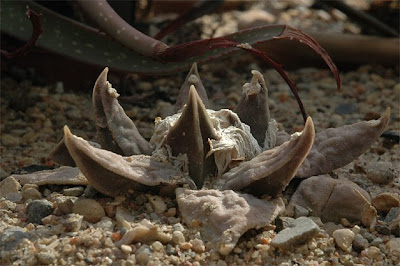
Ariocarpus retusus

Ariocarpus retusus seen from above
Another beauty growing among much larger plants is a (slightly dehydrated) Astrophytum asterias.

Astrophytum asterias
The cactus house holds a large collection of Mammillaria as for example this Mammillaria prolifera var. texana that certainly lives up to its name.

Mammillaria prolifera var. texana
Back in the propagation house a group of Strombocactus disciformis was also on display. The plants are growing in rocks mimicking their natural habitat.

Strombocactus disciformis
My previous post on the Copenhagen Botanical Garden & Museum featured several pictures of the greenhouses so I won't bring any here except for a photo showing the top of the main greenhouse reflected in the water lilly pool in front of it.

Greenhouse reflected in the water lilly pool
Sunday, July 20, 2008
New plants for the coldhouse
Last week I received a new batch of plants from Kakteen Kliem. The plants are going to live in my coldhouse so I selected plants originating from habitats where they are naturally exposed to frost - I hope this also gives them the ability to withstand the freezing conditions they have to endure during winter here in Denmark. 
Lophophora williamsii (JJH 8608293; Pecos River, Texas)
I already have several of these Trans-Pecos Lophophora williamsii plants but decided to procure a few more as Kliem’s stock is running low.
Ariocarpus fissuratus (SB 403; Crockett County, Texas)
My few coldhouse grown Ariocarpus fissuratus plants have all survived until now so I felt like adding some more to the collection ;-)
Homalocephala texensis (DJF 891.3; Yoakum County, Texas)
Homalocephala texensis (aptly named the “Horse Crippler”) is a first for me - I’m looking forward to watching these plants grow and develop their characteristic heavy spine armor.
Normanbokea valdeziana (SB 1468; Ramos Arizpe, Coahuila, Mexico)
Normanbokea valdeziana is another first. I’m not quite sure what to expect from these plants but I fell for their fuzzy looks and beautiful flowers.
As always Gerhard Kliem’s plants are of an excellent quality.
Saturday, March 29, 2008
Ariocarpus and Epithelantha - experiments in cold hardiness, 2008
Since 2004 I've experimented with growing Lophophora, Epithelantha, and Acharagma in an unheated greenhouse in Denmark. Last year I also added some Ariocarpus plants to the experiment, both seed grown and larger plants bought from Mesa garden. This winter has (as usual, I'm tempted to say) been damp but not very cold - the coldest temperature registered inside the coldhouse was -5C (23F) so most plants are doing great. 
Ariocarpus fissuratus (JM122; Pecos County, Texas)
Last year I bought a couple of Ariocarpus fissuratus (JM122; Pecos County, Texas) plants from Mesa Garden. Coming out of winter they are still looking good and seem to have coped well with the cold.
The Epithelantha plants pictured below were started from seed in 2004 and look like they are large enough to start flowering soon. 
Epithelantha micromeris v. greggii (Cuesta la Muralla, Coahuila, Mexico)
Apart from Epithelantha micromeris v. gregii I'm also growing the "regular" variety of Epithelantha micromeris. In my experience the regular micromeris is slightly slower growing than the greggii variety.
Epithelantha micromeris (SB1327; near Belen, New Mexico)
All of my Ariocarpus (including last year's seedlings) and Epithelantha plants made it through winter without damage. The next post describes how my Lophophora plants are doing after the winter.
All Time Most Popular Posts
-
Lophophora williamsii (peyote) populations have diminished in large areas of South Texas where peyoteros harvest the cactus for ceremonial ...
-
On various occasions I've been asked what growing media I'm using for my cactus plants. I don't have a set soil mix recipe as su...
-
Below is a list of retailers/nurseries selling cactus seed and plants. I've only listed vendors I've done business with. If you ar...
-
Most cacti are easily grown from seed - and with a little patience and care they can be grown into beautiful plants. Lophophora williamsi...
-
In last month’s post on the troubled Texan peyoteros I referred to Anderson’s article on the peyote situation in Texas. Given the importanc...
-
Yet another slightly off topic and probably not entirely politically correct post, but I couldn’t help noticing the similarity of my monstr...
-
Flowering stand of San Pedro cacti (Trichocereus pachanoi) To me the main draw of the San Pedro cactus ( Trichocereus pachanoi (syn. Ech...
-
In the June 2008 issue of the Cactus & Co magazine Jaroslav Šnicer, Jaroslav Bohata, and Vojtěch Myšák described a new Lophophora spec...
-
There seems to be an increased focus on the alarming Texas peyote situation. A couple of weeks ago the Houston Press published a mournful, i...
-
I spent two weeks working in Delhi, India during January. I had one weekend off and had planned to spend it in Delhi at my own leisure, but ...


















